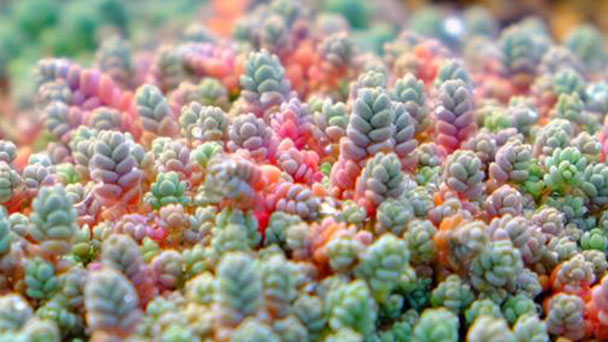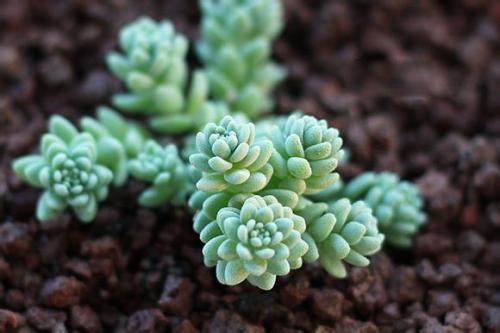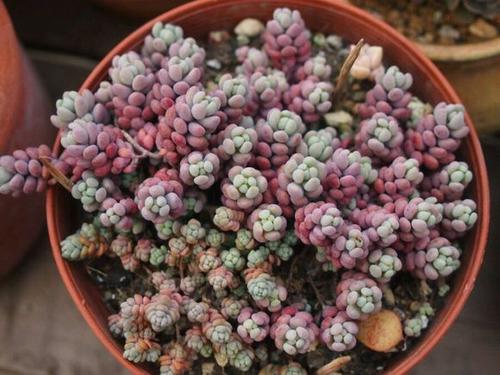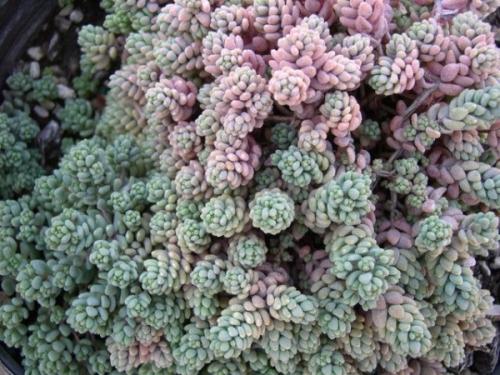Sedum Dasyphyllum profile
Written by Maggie
Oct 13 2021

Sedum Dasyphyllum is a succulent of the genus Sedum in the Sedum family. It is native to arid regions in West Asia and North Africa, mainly distributed in south, central, and southeast Asia Minor peninsula, it prefers warm, dry and sunny environments. It is very suitable for decoration in sunny windowsills, balconies and bedrooms. It is also unique as a groundcover plant in cool and dry areas.
Sedum Dasyphyllum picture

Sedum Dasyphyllum morphological characteristics
Sedum dasyphyllum is a succulent perennial herb, with branching stems, bulged alternate leaves, obovate, succulent leaves, dark green. The plant is 5-10 cm tall, stems much branched, leaves swollen, alternate, obovate, 2 cm long, green, fleshy leaves, dark green, like emerald-green, fleshy leaves bright and beautiful under sunlight. It blooms in spring with pale pink and white flowers.
Sedum Dasyphyllum ecological habits
Sedum Dasyphyllum welcomes warm, dry and sunny conditions. It is more resistant to cold, afraid of wet water, drought resistant saline-alkali resistance.
Sedum Dasyphyllum sunshine temperature
Sedum Dasyphyllum likes plenty of light and takes care of shade in summer to keep the air flowing.The suitable temperature for growth is 13~23℃, and the temperature in winter is not less than 5℃.
Sedum Dasyphyllum selected soil
Choose earthen devices that are slightly larger than the plant. sedum dasyphyllum doesn't require much in the way of soil. It can be mixed with garden soil, leaf rot soil, coarse sand, bone meal or coal cinder mixed peat.

Watering and fertilizer for Sedum Dasyphyllum
Spring and autumn are the growing season for Sedum Dasyphyllum. Watering should be "dry and thorough", keeping the soil moderately dry between watering and controlling watering during winter and summer heat and rest periods, rather than dry and wet. Long-term application of nitrogen, phosphorus and potassium once a month should be uniform. Excessive application of nitrogen would cause internode elongation, leaf evacuation and plant type variation.
Sedum Dasyphyllum breeding trim
Plant division, sowing, cuttage can be.
Sedum Dasyphyllum growth environment
Sedum Dasyphyllum is native to the arid regions of Western Asia and North Africa. It prefers warm, dry and sunny environments. It is more resistant to cold, afraid of wet water, drought resistance. Sandy loam should be fertile, loose and well drained. The suitable temperature for growth is 13-23℃, and the temperature in winter is not less than 5℃. In summer high temperature and strong light, we should appropriately shade it, but shade time should not be too long, otherwise the stems and leaves are soft, easy to lodging. It can be sunny in autumn. Spring and autumn growing season watering "dry thoroughly irrigate", between two watering to keep basin soil moderately dry, winter and summer high temperature dormant period control watering, rather dry not wet.
Sedum Dasyphyllum distribution
Sedum Dasyphyllum is found mainly in southern, central, and southeastern Asia Minor.
Sedum Dasyphyllum's main value
Sedum Dasyphyllum is perfect for sunny windowsills, balconies and bedrooms. The use of groundcover plants in cool, dry climates is also unique.
It should be noted that the polyplasma plants of Crassulaceae do not have the function of radiation protection and formaldehyde resistance.
Latest Updated
- Benefits of Bugleweed - 7 Science-backed Health Benefits
- Bugleweed Dangers & Side Effects - Is It Poisonous?
- How to Plant Evergreen Trees - What You Should Know
- When to Plant Evergreens - Grow Guide for Evergreen Trees
- 12 Wonderful Evergreen Shrubs for Your Garden
- 12 Popular Evergreen Plants with Pictures for Beginners
- When And How To Prune A Lilac Bush Like a Pro
- How to Grow & Care for Lilac Vine (Hardenbergia Violacea)
- Japanese Lilac Tree (Syringa Reticulata) Care & Propagation Guide
- Shumard Oak Pros and Cons - What to Know
Popular Articles
- Winter maintenance of Antirrhinum Majus
- How to Grow Terminalia Mantaly Tree
- How to Grow and Care for Crossostephium Chinense
- How to grow Antirrhinum Majus in spring
- Peristeria Elata (Dove Orchid) Profile: Info & Care Guide
- Underwatered Snake Plant (Sansevieria Trifasciata) - Signs And How To Fix
- How to Care for Brazilian Jasmine Plant (Mandevilla Sanderi)
- How to Grow & Care for Graptopetalum Purple Delight in Summer
- Rosa Chinensis (China Rose): Plant Growing & Care Tips
- How to Care for Baby Sun Rose (Aptenia Cordifolia)